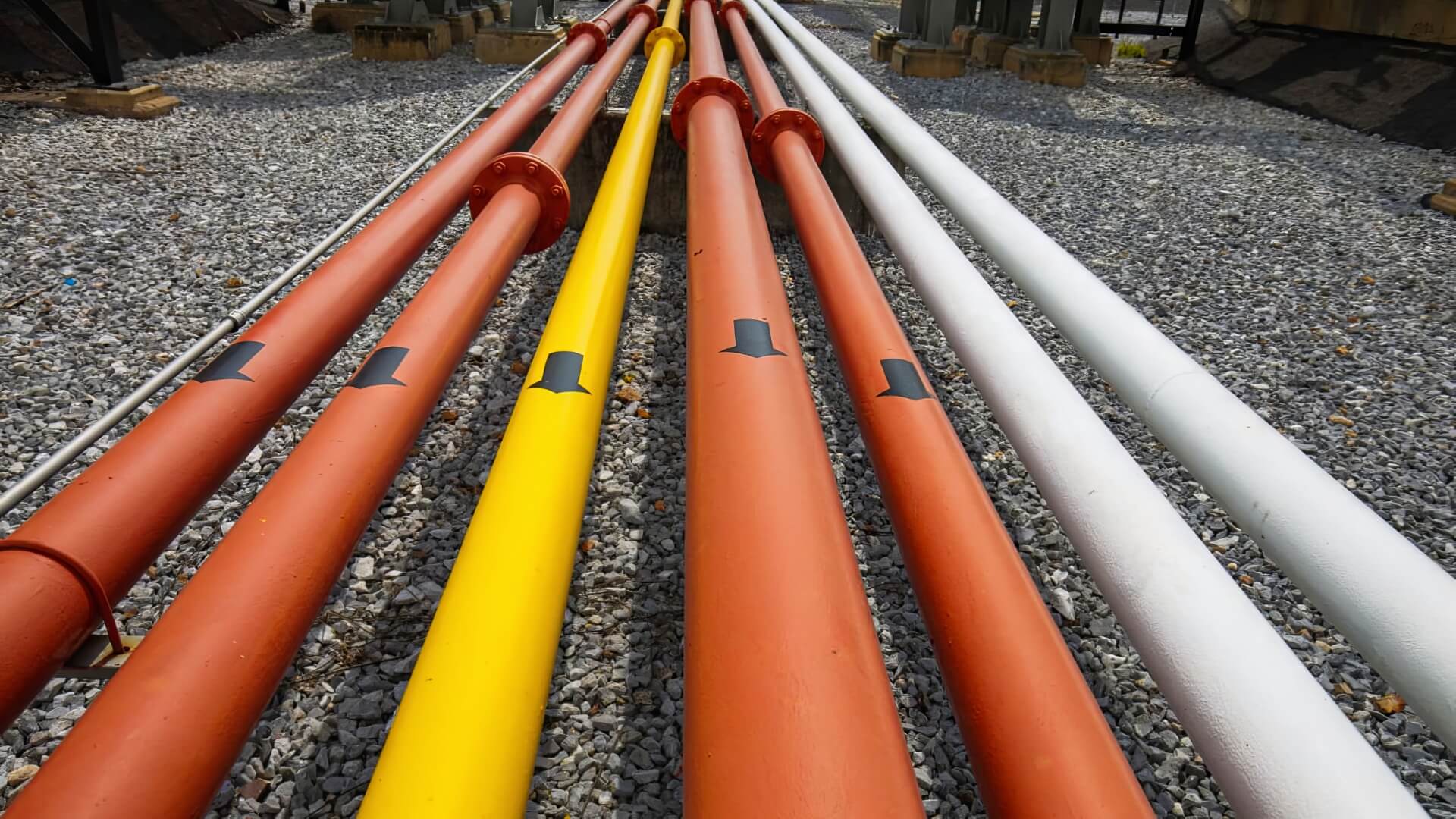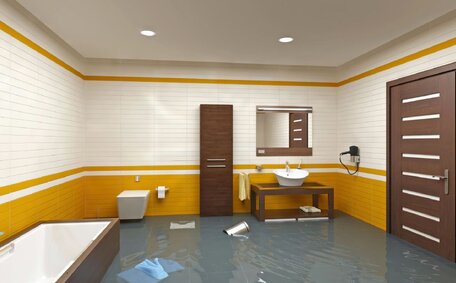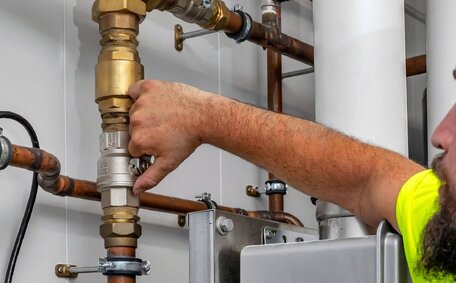Introduction to Fire Sprinkler Systems
Fire sprinkler systems actively detect and quell building fires by utilising a water supply network of pipes and distributed sprinkler heads.
The sprinkler heads contain a heat-sensitive trigger that activates when the surrounding temperature reaches a preset threshold, typically 155-165°F. Activated heads release water to suppress the fire.
A typical fire sprinkler system layout has main supply pipes running along the building structure, with smaller branch pipe networks spreading out to cover all rooms. The sprinkler heads are strategically placed to ensure complete coverage, usually spaced 8-12 feet apart.
Regular maintenance and inspection of fire sprinkler systems significantly elevate building fire safety. Quick activation and water discharge control flames rapidly, minimise damage and give occupants extra time to evacuate.
How Corrosion and Leaks Impact Fire Sprinkler Systems
Corrosion and leaks can severely impact the effectiveness of your fire suppression capabilities. As pipes and fittings corrode over time, the buildup of rust and scale inside the pipes leads to restricted water flow. Overlooked small leaks also diminish water pressure.
According to the National Fire Protection Association, almost 28% of sprinkler failures stem from insufficient water discharged during activation. This is often because corrosion or unidentified leaks have reduced supply pressure below the minimum required thresholds.
Strange noises from the pipes can also indicate internal corrosion.
Make sure to address these issues promptly. Low water pressure from corrosion can lead to inadequate fire suppression, increasing risks and damage.
Early signs of corrosion may be detected through annual inspections, potentially forestalling leaks. Where corrosion is widespread, investing in repair services like steel sectional replacement may be necessary to restore full fire protection capabilities.
Overview of Pipe Relining for Fire Sprinkler Systems
Pipe Relining offers a trenchless, non-invasive alternative to replacing corroded sections of your fire sprinkler system. Specialist contractors use epoxy resins to create a smooth new pipe liner inside the old pipes.
Fire protection systems use ICC-ES PMG-1532 certified liners, like NuFlow 7000, made from quality polyester or vinyl ester resin. These resins ensure required pressure, flow, and fire resistance, essential to restoring system performance.
This resin saturates into cracks and holes in the pipe walls, sealing leaks.
Pipe relining, an ISO 9001-certified solution, extends pipe life over 50 years without further corrosion or leaks. As it doesn’t require new pipe access through walls/ceilings, it prevents damage to facility decor and assets during works.
Benefits of Relining Over Replacement
Relining your fire sprinkler system offers considerable advantages over full system replacement:
- Save up to 50% as relining bypasses the expense of removing pipes and surface restoration.
- Much less business disruption - Work is completed with minimum dust, noise and access requirements, allowing facilities to remain fully operational.
- No loss of space - Keeping the existing pipe layout avoids having to sacrifice room to re-route replacement pipes.
- Enhanced flow efficiency - Smooth resin liners in pipes reduce friction, boosting pressure.
- Durability assured - The 10-year guarantee on resin liners offers protection against future corrosion and leaks.
- Fire rating certified - Liner materials like NuFlow 7000 meet necessary standards for fire sprinkler service.
- Ideal for difficult access areas - Relining avoids the headache of accessing complicated pipe routes through walls and ceilings.
- Sustainable - Extending the service life of existing system components is an eco-friendly solution.
Types of Systems Suitable for Relining
The majority of fire sprinkler systems can be successfully relined regardless of the pipe materials used. This includes:
- Copper - Common in residential and commercial sprinkler systems until the 1960s. Susceptible to pinhole leaks.
- Black steel - The most widely used sprinkler pipe material. Prone to rust and inner wall pitting over time.
- Galvanised steel - Zinc coating provides temporary corrosion protection but still requires relining after 20-30 years.
Quality epoxy resins like NuFlow 7000 can line a wide range of pipe diameters from 1⁄2” to 12”. Pipes with larger diameters may need several liners to ensure complete coverage. NuFlow 7000 maintains integrity after exposure to temperatures up to 1400°F for 2 hours, confirming its suitability for fire sprinkler applications.
This minimises costs where corrosion is concentrated in certain areas rather than systemwide. Provided flow efficiencies and system integrity are maintained post-repair, selective relining offers a great value maintenance option.
Considerations for Compliance and Effectiveness
It is crucial for facility managers and building owners to ensure any relining work complies fully with your fire safety codes and standards. The relined pipes must be capable of delivering the mandated water densities to provide adequate fire suppression.
Consult a certified sprinkler contractor prior to relining to ensure materials and methods meet all certifications. Inferior products that degrade under heat jeopardise the system and can cause failure in emergencies.
Notify your insurance provider regarding plans to reline sprinkler piping, even if temporary impairments are unavoidable during works. Ensure your bill remains unaffected, assuming the system passes post-relining hydrostatic and flow tests.
Although high-quality resins comply with codes, ensure contractors are fully qualified to avoid substandard work. Always verify licences, expertise and ISO-certified quality assurance before hiring. Appropriate relining restores optimal functionality, allowing the system to manage high water pressures effectively.
Beyond meeting stated flow rates, relined sprinkler systems should undergo visual inspections and annual fire pump tests to check for leaks and verify operational integrity. Regular testing ensures that relining has successfully extended the system’s lifespan without impairing fire response functions.
Maintenance Tips for Relined Fire Sprinkler Systems
To maximise longevity of relined fire sprinkler systems and ensure ongoing performance, facility managers should follow these maintenance tips:
- Regular visual checks for leaks, damage, or obstructions safeguard water flow.
- Quarterly testing of alarms and water flow ensures activation devices and pressure levels conform to specifications.
- Promptly replace damaged components to curb deterioration. Leaks that need repair can accelerate corrosion.
- Flush sediment from the water main drain lines annually. Debris buildup impedes water delivery through fire sprinkler heads.
- Check your sprinkler tanks every 6 months. Top up levels to specifications and treat algae or bacteria growth if detected.
- Evaluate strainers and filters for blockages inhibiting system pressure. Routine cleaning or replacement preserves designed flow rates.
- Confirm any alterations or additions to your building adhere to the original sprinkler installation standards.
- Review relined sections after 3-5 years. Further spot repairs may be required if initial corrosion levels were high.
- Record all inspection dates, tests, activations and maintenance work. Updated documentation proves continued diligence.
Active maintenance supports the longevity of relined systems, potentially exceeding 50 years. Preventative care reduces risks of failure during emergency events. Engage with a specialist to assess your system’s ongoing integrity.
Cost Comparison: Relining vs Replacement
When evaluating whether to reline or fully replace an ageing fire sprinkler system, cost is often the deciding factor. Replacing the entire system can be prohibitively expensive compared to targeted relining.
According to industry averages, relining existing pipes costs approximately 50-60% less than complete replacement. For instance, relining costs approximately $22,500 for a 900 square metre commercial space estimated at $45,000 for a new sprinkler system, yielding savings above $20,000.
Savings stem from avoiding the labour and materials needed to remove and dispose of old pipes, along with new pipe purchasing and restoration expenses. Facility downtime and loss of access during works is also minimised.
However, if corrosion has caused significant flow volume reductions below mandated thresholds, sections of piping may still need replacement. Consultation with your local fire systems specialist determines whether remaining wall thickness post-relining can meet pressure requirements.
If repairs exceed 75 percent of a steel system, full replacement may be more economical. Extensive relining also reduces the available diameter for water flow.
In most cases though, epoxy relining extends system life at a fraction of replacement cost. Preventative measures such as regular flushing can readily extend service life by over 50 years.






